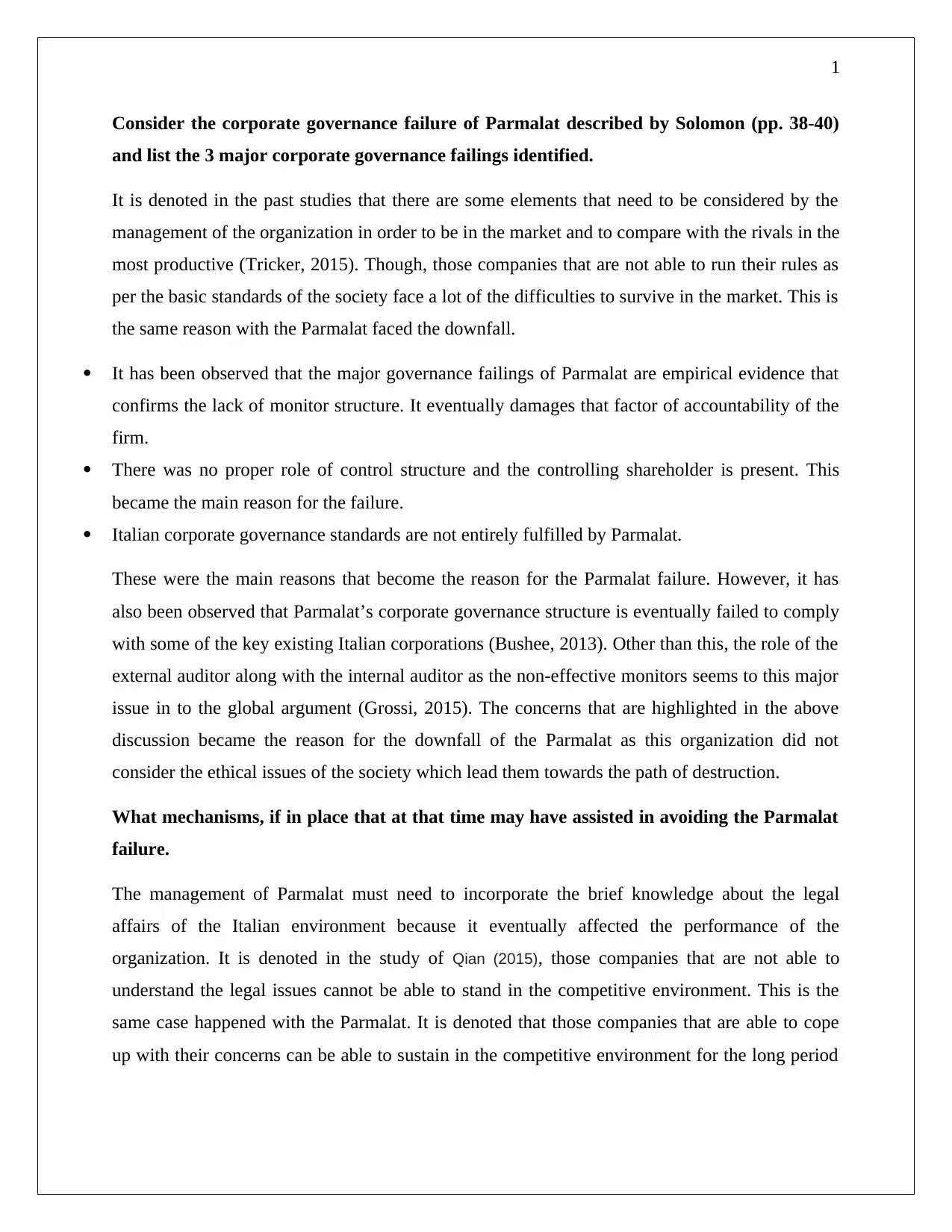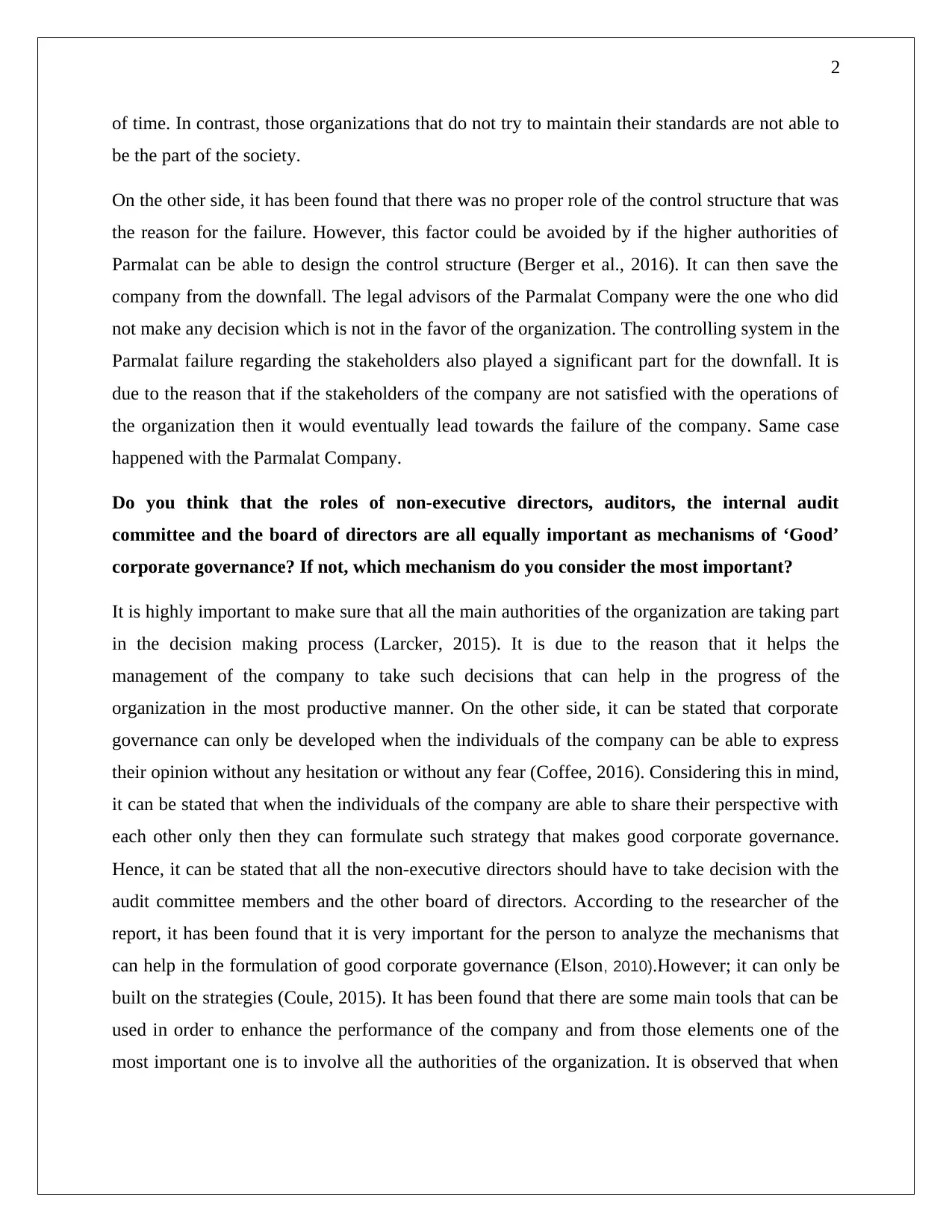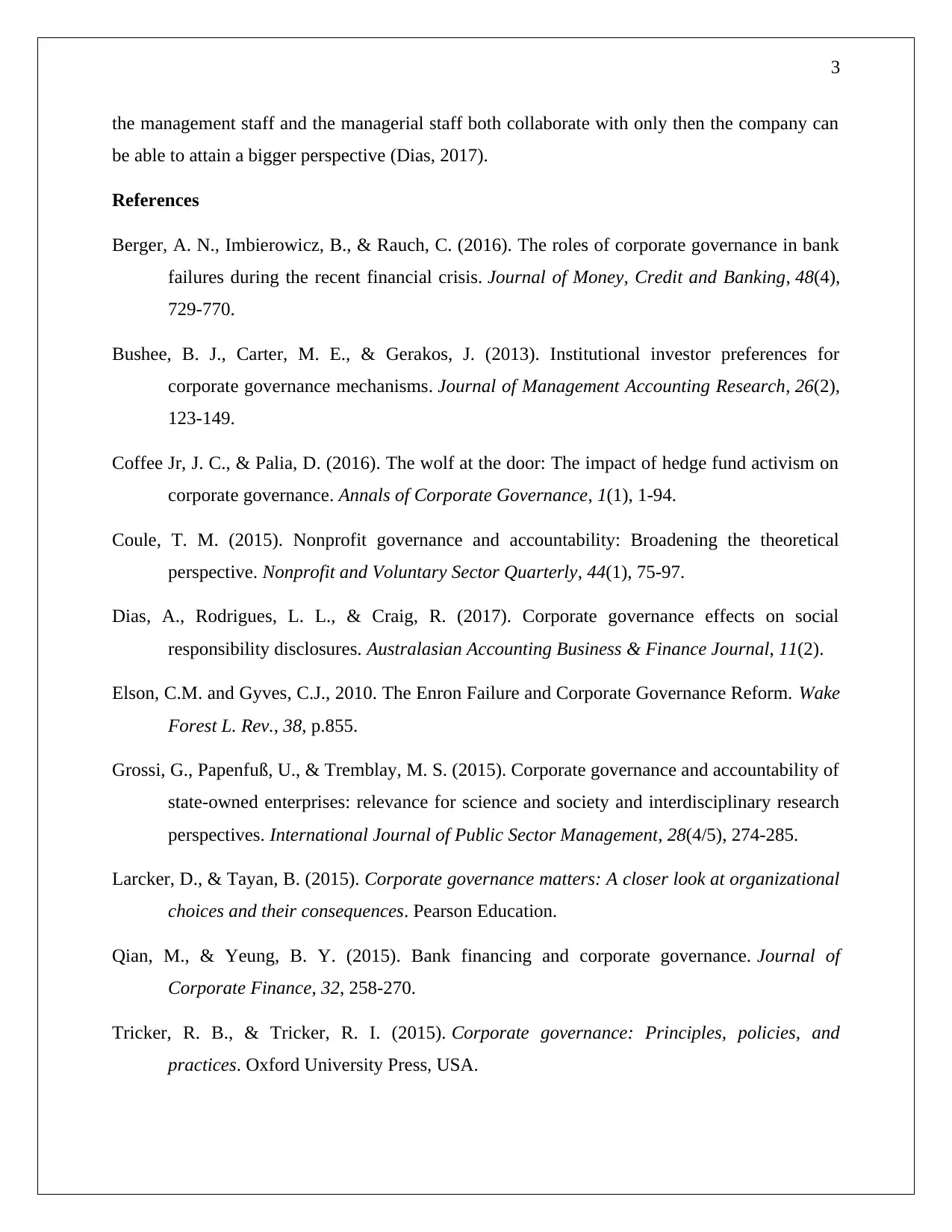Analysis of Parmalat Corporate Governance Failures and Mechanisms
VerifiedAdded on 2020/03/13
|3
|1318
|162
Report
AI Summary
This report examines the corporate governance failures of Parmalat, identifying three major failings: lack of a monitoring structure, absence of a proper control structure, and non-compliance with Italian corporate governance standards. The analysis highlights the importance of accountability, the role of external and internal auditors, and the impact of ethical considerations. The report explores mechanisms that could have prevented the failure, such as incorporating knowledge of Italian legal affairs and establishing a strong control structure. It also discusses the relative importance of non-executive directors, auditors, the internal audit committee, and the board of directors in fostering good corporate governance, emphasizing the need for collaboration and the expression of diverse opinions within the organization. The study underscores the significance of effective corporate governance in preventing financial crises and ensuring the long-term sustainability of companies, referencing several academic sources.

1
Consider the corporate governance failure of Parmalat described by Solomon (pp. 38-40)
and list the 3 major corporate governance failings identified.
It is denoted in the past studies that there are some elements that need to be considered by the
management of the organization in order to be in the market and to compare with the rivals in the
most productive (Tricker, 2015). Though, those companies that are not able to run their rules as
per the basic standards of the society face a lot of the difficulties to survive in the market. This is
the same reason with the Parmalat faced the downfall.
It has been observed that the major governance failings of Parmalat are empirical evidence that
confirms the lack of monitor structure. It eventually damages that factor of accountability of the
firm.
There was no proper role of control structure and the controlling shareholder is present. This
became the main reason for the failure.
Italian corporate governance standards are not entirely fulfilled by Parmalat.
These were the main reasons that become the reason for the Parmalat failure. However, it has
also been observed that Parmalat’s corporate governance structure is eventually failed to comply
with some of the key existing Italian corporations (Bushee, 2013). Other than this, the role of the
external auditor along with the internal auditor as the non-effective monitors seems to this major
issue in to the global argument (Grossi, 2015). The concerns that are highlighted in the above
discussion became the reason for the downfall of the Parmalat as this organization did not
consider the ethical issues of the society which lead them towards the path of destruction.
What mechanisms, if in place that at that time may have assisted in avoiding the Parmalat
failure.
The management of Parmalat must need to incorporate the brief knowledge about the legal
affairs of the Italian environment because it eventually affected the performance of the
organization. It is denoted in the study of Qian (2015), those companies that are not able to
understand the legal issues cannot be able to stand in the competitive environment. This is the
same case happened with the Parmalat. It is denoted that those companies that are able to cope
up with their concerns can be able to sustain in the competitive environment for the long period
Consider the corporate governance failure of Parmalat described by Solomon (pp. 38-40)
and list the 3 major corporate governance failings identified.
It is denoted in the past studies that there are some elements that need to be considered by the
management of the organization in order to be in the market and to compare with the rivals in the
most productive (Tricker, 2015). Though, those companies that are not able to run their rules as
per the basic standards of the society face a lot of the difficulties to survive in the market. This is
the same reason with the Parmalat faced the downfall.
It has been observed that the major governance failings of Parmalat are empirical evidence that
confirms the lack of monitor structure. It eventually damages that factor of accountability of the
firm.
There was no proper role of control structure and the controlling shareholder is present. This
became the main reason for the failure.
Italian corporate governance standards are not entirely fulfilled by Parmalat.
These were the main reasons that become the reason for the Parmalat failure. However, it has
also been observed that Parmalat’s corporate governance structure is eventually failed to comply
with some of the key existing Italian corporations (Bushee, 2013). Other than this, the role of the
external auditor along with the internal auditor as the non-effective monitors seems to this major
issue in to the global argument (Grossi, 2015). The concerns that are highlighted in the above
discussion became the reason for the downfall of the Parmalat as this organization did not
consider the ethical issues of the society which lead them towards the path of destruction.
What mechanisms, if in place that at that time may have assisted in avoiding the Parmalat
failure.
The management of Parmalat must need to incorporate the brief knowledge about the legal
affairs of the Italian environment because it eventually affected the performance of the
organization. It is denoted in the study of Qian (2015), those companies that are not able to
understand the legal issues cannot be able to stand in the competitive environment. This is the
same case happened with the Parmalat. It is denoted that those companies that are able to cope
up with their concerns can be able to sustain in the competitive environment for the long period
Paraphrase This Document
Need a fresh take? Get an instant paraphrase of this document with our AI Paraphraser

2
of time. In contrast, those organizations that do not try to maintain their standards are not able to
be the part of the society.
On the other side, it has been found that there was no proper role of the control structure that was
the reason for the failure. However, this factor could be avoided by if the higher authorities of
Parmalat can be able to design the control structure (Berger et al., 2016). It can then save the
company from the downfall. The legal advisors of the Parmalat Company were the one who did
not make any decision which is not in the favor of the organization. The controlling system in the
Parmalat failure regarding the stakeholders also played a significant part for the downfall. It is
due to the reason that if the stakeholders of the company are not satisfied with the operations of
the organization then it would eventually lead towards the failure of the company. Same case
happened with the Parmalat Company.
Do you think that the roles of non-executive directors, auditors, the internal audit
committee and the board of directors are all equally important as mechanisms of ‘Good’
corporate governance? If not, which mechanism do you consider the most important?
It is highly important to make sure that all the main authorities of the organization are taking part
in the decision making process (Larcker, 2015). It is due to the reason that it helps the
management of the company to take such decisions that can help in the progress of the
organization in the most productive manner. On the other side, it can be stated that corporate
governance can only be developed when the individuals of the company can be able to express
their opinion without any hesitation or without any fear (Coffee, 2016). Considering this in mind,
it can be stated that when the individuals of the company are able to share their perspective with
each other only then they can formulate such strategy that makes good corporate governance.
Hence, it can be stated that all the non-executive directors should have to take decision with the
audit committee members and the other board of directors. According to the researcher of the
report, it has been found that it is very important for the person to analyze the mechanisms that
can help in the formulation of good corporate governance (Elson, 2010).However; it can only be
built on the strategies (Coule, 2015). It has been found that there are some main tools that can be
used in order to enhance the performance of the company and from those elements one of the
most important one is to involve all the authorities of the organization. It is observed that when
of time. In contrast, those organizations that do not try to maintain their standards are not able to
be the part of the society.
On the other side, it has been found that there was no proper role of the control structure that was
the reason for the failure. However, this factor could be avoided by if the higher authorities of
Parmalat can be able to design the control structure (Berger et al., 2016). It can then save the
company from the downfall. The legal advisors of the Parmalat Company were the one who did
not make any decision which is not in the favor of the organization. The controlling system in the
Parmalat failure regarding the stakeholders also played a significant part for the downfall. It is
due to the reason that if the stakeholders of the company are not satisfied with the operations of
the organization then it would eventually lead towards the failure of the company. Same case
happened with the Parmalat Company.
Do you think that the roles of non-executive directors, auditors, the internal audit
committee and the board of directors are all equally important as mechanisms of ‘Good’
corporate governance? If not, which mechanism do you consider the most important?
It is highly important to make sure that all the main authorities of the organization are taking part
in the decision making process (Larcker, 2015). It is due to the reason that it helps the
management of the company to take such decisions that can help in the progress of the
organization in the most productive manner. On the other side, it can be stated that corporate
governance can only be developed when the individuals of the company can be able to express
their opinion without any hesitation or without any fear (Coffee, 2016). Considering this in mind,
it can be stated that when the individuals of the company are able to share their perspective with
each other only then they can formulate such strategy that makes good corporate governance.
Hence, it can be stated that all the non-executive directors should have to take decision with the
audit committee members and the other board of directors. According to the researcher of the
report, it has been found that it is very important for the person to analyze the mechanisms that
can help in the formulation of good corporate governance (Elson, 2010).However; it can only be
built on the strategies (Coule, 2015). It has been found that there are some main tools that can be
used in order to enhance the performance of the company and from those elements one of the
most important one is to involve all the authorities of the organization. It is observed that when

3
the management staff and the managerial staff both collaborate with only then the company can
be able to attain a bigger perspective (Dias, 2017).
References
Berger, A. N., Imbierowicz, B., & Rauch, C. (2016). The roles of corporate governance in bank
failures during the recent financial crisis. Journal of Money, Credit and Banking, 48(4),
729-770.
Bushee, B. J., Carter, M. E., & Gerakos, J. (2013). Institutional investor preferences for
corporate governance mechanisms. Journal of Management Accounting Research, 26(2),
123-149.
Coffee Jr, J. C., & Palia, D. (2016). The wolf at the door: The impact of hedge fund activism on
corporate governance. Annals of Corporate Governance, 1(1), 1-94.
Coule, T. M. (2015). Nonprofit governance and accountability: Broadening the theoretical
perspective. Nonprofit and Voluntary Sector Quarterly, 44(1), 75-97.
Dias, A., Rodrigues, L. L., & Craig, R. (2017). Corporate governance effects on social
responsibility disclosures. Australasian Accounting Business & Finance Journal, 11(2).
Elson, C.M. and Gyves, C.J., 2010. The Enron Failure and Corporate Governance Reform. Wake
Forest L. Rev., 38, p.855.
Grossi, G., Papenfuß, U., & Tremblay, M. S. (2015). Corporate governance and accountability of
state-owned enterprises: relevance for science and society and interdisciplinary research
perspectives. International Journal of Public Sector Management, 28(4/5), 274-285.
Larcker, D., & Tayan, B. (2015). Corporate governance matters: A closer look at organizational
choices and their consequences. Pearson Education.
Qian, M., & Yeung, B. Y. (2015). Bank financing and corporate governance. Journal of
Corporate Finance, 32, 258-270.
Tricker, R. B., & Tricker, R. I. (2015). Corporate governance: Principles, policies, and
practices. Oxford University Press, USA.
the management staff and the managerial staff both collaborate with only then the company can
be able to attain a bigger perspective (Dias, 2017).
References
Berger, A. N., Imbierowicz, B., & Rauch, C. (2016). The roles of corporate governance in bank
failures during the recent financial crisis. Journal of Money, Credit and Banking, 48(4),
729-770.
Bushee, B. J., Carter, M. E., & Gerakos, J. (2013). Institutional investor preferences for
corporate governance mechanisms. Journal of Management Accounting Research, 26(2),
123-149.
Coffee Jr, J. C., & Palia, D. (2016). The wolf at the door: The impact of hedge fund activism on
corporate governance. Annals of Corporate Governance, 1(1), 1-94.
Coule, T. M. (2015). Nonprofit governance and accountability: Broadening the theoretical
perspective. Nonprofit and Voluntary Sector Quarterly, 44(1), 75-97.
Dias, A., Rodrigues, L. L., & Craig, R. (2017). Corporate governance effects on social
responsibility disclosures. Australasian Accounting Business & Finance Journal, 11(2).
Elson, C.M. and Gyves, C.J., 2010. The Enron Failure and Corporate Governance Reform. Wake
Forest L. Rev., 38, p.855.
Grossi, G., Papenfuß, U., & Tremblay, M. S. (2015). Corporate governance and accountability of
state-owned enterprises: relevance for science and society and interdisciplinary research
perspectives. International Journal of Public Sector Management, 28(4/5), 274-285.
Larcker, D., & Tayan, B. (2015). Corporate governance matters: A closer look at organizational
choices and their consequences. Pearson Education.
Qian, M., & Yeung, B. Y. (2015). Bank financing and corporate governance. Journal of
Corporate Finance, 32, 258-270.
Tricker, R. B., & Tricker, R. I. (2015). Corporate governance: Principles, policies, and
practices. Oxford University Press, USA.
⊘ This is a preview!⊘
Do you want full access?
Subscribe today to unlock all pages.

Trusted by 1+ million students worldwide
1 out of 3
Related Documents
Your All-in-One AI-Powered Toolkit for Academic Success.
+13062052269
info@desklib.com
Available 24*7 on WhatsApp / Email
![[object Object]](/_next/static/media/star-bottom.7253800d.svg)
Unlock your academic potential
Copyright © 2020–2025 A2Z Services. All Rights Reserved. Developed and managed by ZUCOL.





